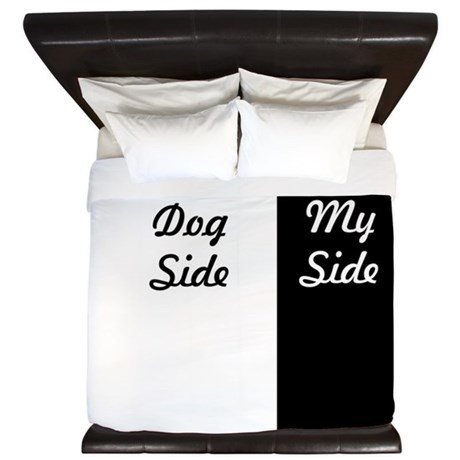
You’ve always suspected it to be true: A sleeping dog takes up half the bed, if not more. Ohhh, you might go to sleep with the dog taking up a small corner of the bed, but when you wake up, the dog is stretched out with a paw pointed towards each corner of the mattress, and you have as much space as the pillow. Is sleeping with the dog a good idea?
A recent Mayo Clinic study found that on average, people with dogs in their rooms (but not on their beds) have an 83% sleep efficiency—a comparison of time spent asleep to total time spent in bed. (80% is generally considered okay.) Sleeping with a dog in the bed, however, was linked to a slightly lower sleep efficiency: an average of around 80%. Though that is considered a satisfactory score, people with dogs in their beds woke up more throughout the night than those whose dogs slept elsewhere. Another survey by the National Institutes of Health called Are Pets in the Bedroom a Problem? however, found that most people who share their beds with their pets say they experience more benefits than drawbacks.
It doesn’t seem to matter since one survey says that half of all dog owners allow their dogs to sleep on the bed, anyway. In an American Pet Products Association survey of dog owners, it was learned that 62% of small dogs, 41% of medium-sized dogs and 32% of large dogs sleep with their owners.
Are you in these numbers?
Dogtime.com published an article postulating that a dog’s sleeping positions and habits reveal a lot about their personality, and while we don’t know how scientifically sound the information is, it’s entertaining to read. We do know that big dogs tend to take sleep more or take longer naps than smaller dogs (one reason Newfoundlands, Mastiffs, St. Bernards, and Great Pyrenees have gotten the nickname “mat dogs”), and that’s saying something when the average dog sleeps 12 – 14 hours a day. Why do dogs sleep so much? Because a dog’s shorter sleep period means that only 10 percent of their snoozing is REM sleep, and that means that dogs need more total sleep in order to get enough of restorative sleep – REM sleep – that they need.
Has anyone ascertained if there are sleep patterns by breed? If they have, we haven’t found a write-up on it yet, but we have come across mention that working dogs, i.e., police dogs, SAR or service dogs, tend to sleep less because they’re active much of the day with their humans, and that livestock guardian dogs may sleep a bit more during the day so they can be “on alert” at night.
How about the amount of sleep by breed? As we mentioned earlier, large breeds tend to sleep more than smaller breeds, but we did find a multitude of lists on the Internet indicating the sleepiest breeds, and some included smaller dogs (none of the lists, by the way, indicated sources for their information). Interestingly, there were several breeds that the lists had in common, but NPDD veterans know that we tend to be skeptical of most lists found on the world wide web, so reader beware.
The breeds that most of such lists had in common were: Saint Bernard, Great Dane, Mastiff, Basset Hound, Bulldog, Pug, Lhasa Apso and the Shih Tzu. Runners up included the French Bulldog, Clumber Spaniel and Chihuahua. Do you who own these breeds agree?
As for the bedding seen in our thumbnail photograph, you can buy something similar (see the picture above) here.

